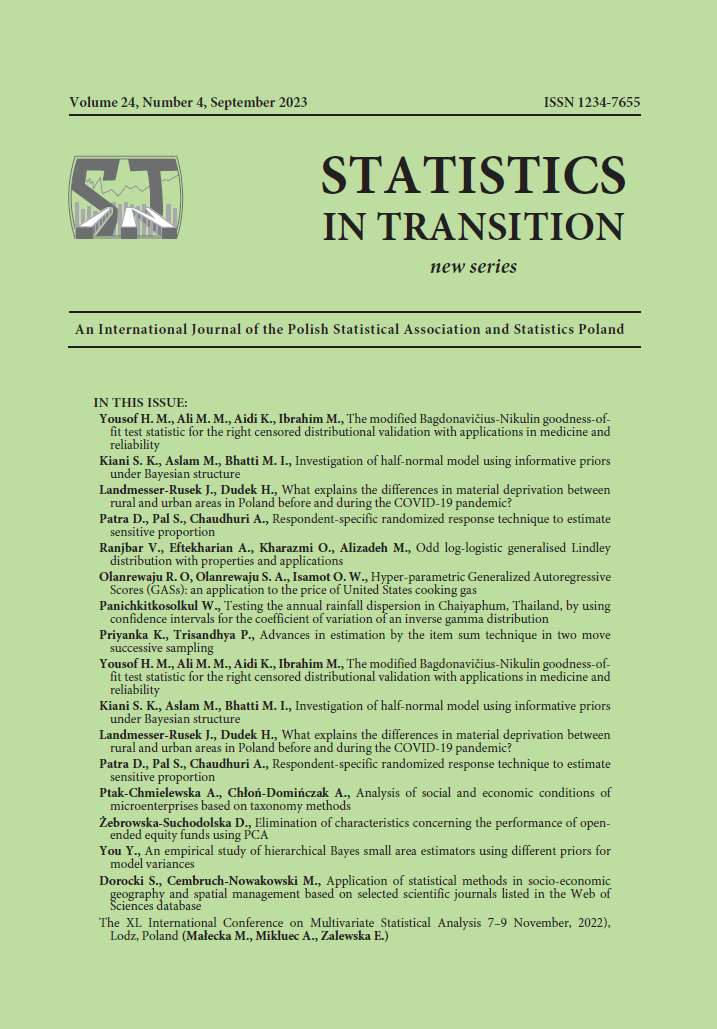© R. O. Olanrewaju, S. A. Olanrewaju, O. W. Isamot. Article available under the CC BY-SA 4.0 licence
![]()
ARTICLE
ABSTRACT
This paper presents the framework of the Generalized Autoregressive Score (GAS) model with a variety of symmetric conditional densities of different time-varying hyperparameters. The distinctive trait and goal of the observation-driven GAS model is to use its score and information functions as the compeller of time-variation via hyper-parameters of conditional densities. 10 robust hyper-parametric conditional densities were used as random error drivers for the GAS model with an application to the price of the United States cooking gas in the period between 2005 and 2020. Out of the 10 robust hyper-parametric conditional noises for the GAS model, the Asymmetric Student–t with one tail decay parameter (AST1) outperformed other categories of its variants and other conditional densities subjected to the GAS model, achieving a minimum reduced-error performance of AIC=11943.277 and BIC=12014.525. The hyper-parametric model obtained a location score and scale score of - 1.2634 and 0.6636, respectively, while its location information and scale information was 0.2691 and 0.0362, respectively. Furthermore, the GAS model via AST1 proved more efficient than the core volatile conditional heteroscedasticity model of the Generalized Autoregressive Conditional Heteroscedasticity (GARCH) at GARCH (1,1) via a Gaussian distributed noise.
KEYWORDS
Asymmetric Student–t, Generalized Autoregressive Score, hyper-parameters, score, information.
REFERENCES
Blasques, F., Koopman, S. J., Łasak, K., Lucas, A., (2016). In-Sample Confidence Bands and Out-of-Sample Forecast Bands for Time-Varying Parameters in Observation- Driven Models. International Journal of Forecasting, Vol. 32(3), pp. 875–887, doi: 10.1016/j.ijforecast.2015. 11.018.
Cox, D. R., (1981). Statistical analysis of time series: some recent developments. Scandinavian Journal of Statistics, Vol. 8(2), pp. 93–115.
Creal, D., Koopman, S.J., Lucas, A., (2013). Generalized Autoregressive Score Models with Applications. Journal of Applied Econometric, Vol. 28(5), pp. 777–795. https://doi.org/10.1002/jae.1279.
Janus, P., Koopman, S. J., Lucas, A., (2014). Long Memory Dynamics for Multivariate Dependence under Heavy Tails. Journal of Empirical Finance, Vol. 29, pp. 187–206, doi: 10.1016/j.jempfin, 2014.09.07.
Engle, R. F., (1982). Autoregressive conditional heteroscedasticity with estimates of the variance of United Kingdom inflation. Econometrica, Vol. 50(4), pp. 987–1007.
Hansen, B. E., (1994). Autoregressive conditional density estimation. International Economic Review, Vol. 35 (3), pp. 705–729.
Harvey, A. C, Thiele, S. (2016). Testing Against Changing Correlation. Journal of Empirical Finance, Vol. 38(B), pp. 575–589. doi:10.1016/j.jempfin.2015.09.003.
Harvey, A. C., Sucarrat, G., (2014). EGARCH Models with Fat Tails, Skewness, and Leverage. Computational Statistics & Data Analysis, Vol.76, pp. 320–338, doi: 10.1016/j.csda.2013.09. 022.
Harvey, A. C., Luati, A., (2014). Filtering with Heavy Tails. Journal of the American Statistical Association, Vol. 109(507), pp. 1112–1122, doi: 10.1080/ 01621459.2014.887011.
Harvey, A. C., (2013). Dynamic Models for Volatility and Heavy Tails: With Applications to Financial and Economic Time Series. Cambridge University Press.
Koopman, S. J., Lucas, A., Monteiro, A., (2008). The multi-state latent factor intensity model for credit rating transitions. Journal of Econometrics, Vol. 142(1), pp. 399–424.
Owen, C. B., (2008). Parameter Estimation for the Beta Distribution. Brigham Young University – Provo.
Jones, M. C., Faddy, M. J., (2003). A skew extension of the student t-distribution, with applications. Journal of Royal Statistics Society B,. Vol 65, Part 1, pp. 159–174.
Lucas, A., Zhang, X., (2016). Score-Driven Exponentially Weighted Moving Averages and Value-at-Risk Forecasting. International Journal of Forecasting, Vol. 32(2), pp. 293–302, doi: 10.1016/ j.ijforecast.2015.09.003.
Oh, D. H., Patton, A. J., (2016). Time-Varying Systemic Risk: Evidence from a Dynamic Copula Model of CDS Spreads. Journal of Business & Economic Statistics, Vol. 36(2), pp. 181–195, doi: 10.1080/07350015.2016.1177535.
Olanrewaju, R. O., Ojo J. F., Adekola, L. O., (2020). Bayesian latent autoregressive stochastic volatility: an application of naira to eleven exchangeable currencies rates. Open Journal of Mathematical Sciences, Vol.4 (1), pp. 386–396, doi: 10.30538/oms2020.0128.
Olanrewaju, R. O., Folorunsho, S. A., (2018). Generalized autoregressive score (GAS) functions under Gaussian and Student-t distributions. International Journal of Statistics and Applied Mathematics, Vol. 3(5), Part A, pp. 56–61.
Monache, D. D., Petrella, I., (2014). Adaptive Models and Heavy Tails. School of Economics and Finance, Working Paper No. 720, ISSN 1473-0278.
Shephard, N., (2005). Stochastic Volatility: Selected Readings. Oxford University Press, Oxford.
